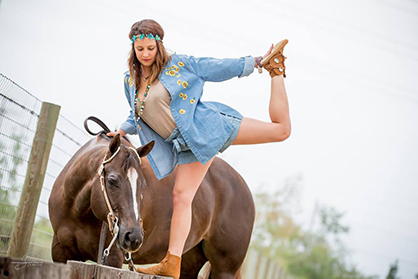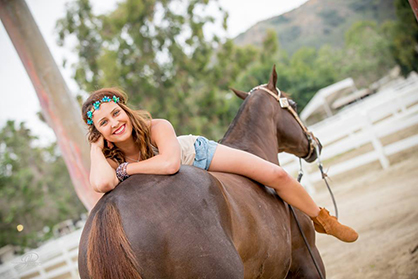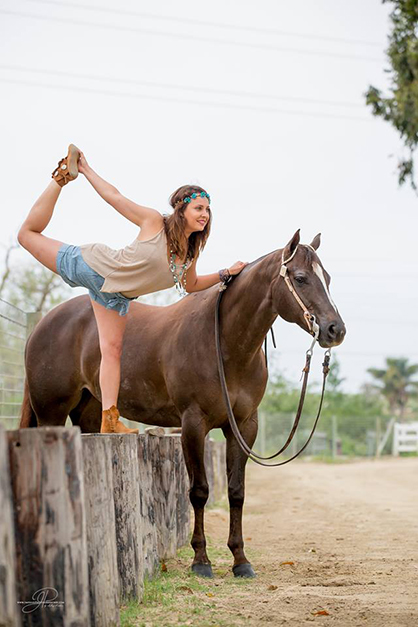How Yoga Completely Changed My Riding, and My Life
Ironically, when Gabrielle Lofton attended her first yoga class at the age of 16, she didn’t enjoy it. Although she had previous dance experience, she found the practice to be very uncomfortable.
“I’m grateful for that experience; because, now that I’ve been teaching for some time, I’ve realized that a lot of people experience the same feelings when they begin the practice,” she says. “I teach a lot of beginners, so I can relate to them when they’re going through those first tough classes.”
After dabbling in a few beginner classes, Gabrielle’s real practice began in January 2013 while attending Miracosta College in San Diego, California. Through a 200-hour Yoga Teacher Training Program she discovered a love for the discipline and immersed herself in the culture.
“I completely submerged myself in the 4,000 plus years of yogic philosophy that I had no clue about before I started my training,” she says. “When I started my training, I literally was yoga illiterate and ignorant. I had no idea that the physical practice (mainstream yoga) is literally this tiny fraction of the true essence of yoga. Before my training, I didn’t know that yoga is truly a spiritual practice that encompasses different branches of philosophies, theologies, meditations, and of course the famous exercise that most of us are familiar with called ‘asana.'”
The physical practice of yoga involves asanas, or yoga positions. The total number of positions is debated among scholars, but there are as many as 84 classic asanas with hundreds of variations. Some of the more common include Child’s Pose (Balasana), Downward Facing Dog (Adho Mukha Svanasana), and Warrior 1 (Virabhadrasana 1).
Since January 2013, Gabrielle’s daily life has involved some type of yoga practice, whether it be meditating, reading, the physical activity, or striving to live in line with the yogic philosophy. Not only has she witnessed a change in her health, spiritual mindset, self-confidence, and overall well-being, she’s also seen a difference in her riding.
Gabrielle was only three years old when she started going to the barn, tagging along during her older sister, Brittany’s, horseback riding lessons. When she was seven years old, she starting competing at local shows before progressing into APHA competition and later AQHA in 2006.
 She’s convinced that yoga has a positive impact on her riding. It’s something her horse trainers have noticed as well. “Throughout the day at shows, or just during a normal riding day, we’re asking our bodies to perform at their best, no matter what we’re physically going through at that time. It takes a toll on our bodies. Most horse people feel that. I practice yoga every day. While at shows, I try to do some yoga every morning and/or night. It makes a huge difference, because it’s not just that I physically don’t hurt after riding, but I also sleep better, I have more energy the next day, and I ride so much better. That’s because re-stretching the muscles after a workout or ride is basically like resetting your physical body. It increases circulation so you gain range of motion and flexibility, which decreases the aches and pains we experience in our bodies. I personally feel the difference in my own body, but my trainers see the difference in my riding, especially when it comes to Horsemanship!”
She’s convinced that yoga has a positive impact on her riding. It’s something her horse trainers have noticed as well. “Throughout the day at shows, or just during a normal riding day, we’re asking our bodies to perform at their best, no matter what we’re physically going through at that time. It takes a toll on our bodies. Most horse people feel that. I practice yoga every day. While at shows, I try to do some yoga every morning and/or night. It makes a huge difference, because it’s not just that I physically don’t hurt after riding, but I also sleep better, I have more energy the next day, and I ride so much better. That’s because re-stretching the muscles after a workout or ride is basically like resetting your physical body. It increases circulation so you gain range of motion and flexibility, which decreases the aches and pains we experience in our bodies. I personally feel the difference in my own body, but my trainers see the difference in my riding, especially when it comes to Horsemanship!”
In addition to the physical benefits Gabrielle has seen from combining yoga and riding, she notes the mental and emotional benefits she’s experienced as well. “When I began my yoga practice in 2013, I was going through a really tough time, personally, and I experienced really low self-esteem. I was at a point in my life where I felt really lost. I’m a really spiritual person, but I just didn’t know where I belonged. When I started my teacher training program and was introduced to the spiritual side of yoga, I gave it all I had, and it has changed my life.”
“I started practicing meditation and that completely changed who I am inside and outside of the show pen. Being really competitive is in my blood, and I expect a lot out of myself. While in my stage of major self-doubt, the effects really came out while in the show pen. It was to the point where I would practice great but absolutely fall apart once in the ring. I’ve shown my entire life, but I still get super nervous when I show. Before yoga, I would let my nerves rule me. But since my meditation practice began, I control my nerves and I have learned how to use my nerves to my benefit. Through yoga I have gained so much self-confidence, and every year I gain more and more.”
In 2013, Gabrielle competed in her last year in the AQHA youth division. That year she’d set a lofty goal to win Youth Trail at the AQHA Youth World Show. She relied on visualization meditations combined with her yoga practice to zero in on her goal, reduce stress, and increase focus. “Every day, when I practiced yoga and meditated, I visualized Lil Bit Western and I winning the class, and we did. I also won at the 2013 Congress in Youth Trail on Up The Assets. It was an amazing year, and I truly believe it wouldn’t have happened if it wasn’t for yoga and meditation.”
For equestrians looking to incorporate a little yoga into their daily lives, Gabrielle suggests Sun Salutations A and B. These flow series are designed to stretch the entire body from head to toe and are meant to be done in the morning and evening. “Each flow probably takes a minute to do, and it’s recommended to do at least three of each,” she says.
Sun Salutation A Flow- Mountain Pose, Raised Arms Pose, Standing Forward Bend, Flat Back, Plank Pose, Four Limbed Staff Pose, Upward Facing Dog, Downward Facing Dog, Standing Forward Bend, Mountain Pose
In addition, Gabrielle suggests reclined twists or supine twists, which help to detoxify the body by flushing out lactic acid build-up after riding. These poses also stretch out the glutes, IT bands, and lateral muscles of the legs, which can cause lower back pain if they’re tight. Another helpful pose is Feet-Up-The-Wall, which Gabrielle touts as being “completely restorative.”
 “15 minutes with your feet up the wall is the equivalent to three hours of your deepest sleep,” she says. “Seriously, the benefits of yoga are limitless in my mind. I have heard, seen, and experienced miracles. I’ve learned that the baby boomer generation always comment on the benefits they feel physically. The working class group comments on the stress-relieving aspect. My college students are very vocal about the emotional benefits and that they’ve noticed how their yoga practice has decreased anxiety attacks, combat stress from school, and how it has boosted their self-confidence.”
“15 minutes with your feet up the wall is the equivalent to three hours of your deepest sleep,” she says. “Seriously, the benefits of yoga are limitless in my mind. I have heard, seen, and experienced miracles. I’ve learned that the baby boomer generation always comment on the benefits they feel physically. The working class group comments on the stress-relieving aspect. My college students are very vocal about the emotional benefits and that they’ve noticed how their yoga practice has decreased anxiety attacks, combat stress from school, and how it has boosted their self-confidence.”
When it comes to incorporating yoga on horseback, Gabrielle says it’s a fun way to practice the “horse and rider connection,” but she ultimately believes the most beneficial poses are done while on the ground. However, incorporating yoga breathing techniques are very helpful while in a competition setting. “There is definitely breath work that can combat nerves. The number one breathing technique I recommend is Ujjayi breath; this is the general yogic breath we use in yoga to draw a quick connection between the mind and body by igniting the parasympathetic nervous system (our rest and digest system). That helps lower blood pressure, heart rate, and helps calm the mind. I personally use this breath before I compete in the show ring, or when I notice anxiety or hypertension kicking in. Another one is called Kapalabhati (breath with fire) and this is the breath you use when you feel horrible, you’re in a bad mood, the world is just a rough place, and you need a quick reset button.”
Perhaps another benefit of yoga for equestrians is the creation of an atmosphere that’s completely judgement free. “The thing to remember about yoga is that it’s very vast, and you only have to go as deep into the yoga world as you’re game for. Yoga was created to make life better. Life wasn’t created to make yoga better. That means it doesn’t matter what your physical practice looks like; it doesn’t matter whether you do it every day or not.”
“Just because you fell off a horse doesn’t make you a bad rider; it makes you experienced. It’s about getting back in the saddle. It’s about stepping back on your mat, getting back to eating healthier, or sitting on your meditation cushion. It’s about perseverance in the journey, not about looking perfect every minute. It’s about learning to accept the failures along with taking the achievements with grace. There are always going to be rocks, potholes, and cracks in the road, but it’s about changing your tire when you get a flat and driving away stronger than before.”











